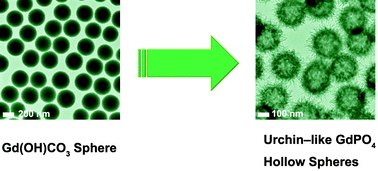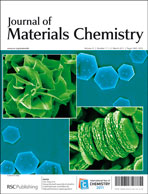In this work, we report a facile solution-phase synthesis of highly uniform and well-dispersed urchin-like GdPO4 hollow spheres (around 250 nm) by utilizing the colloidal spheres of Gd(OH)CO3 as a sacrificial template and NH4H2PO4 as a phosphorus source. Monodisperse urchin-like GdPO4 hollow spheres with controlled size were synthesized through the Kirkendall effect via the hydrothermal process. Nitrogen adsorption–desorption measurements suggest the presence of mesopores (av. 18.8 nm) in these hollow spheres. In addition, Eu3+-doped GdPO4 hollow spheres exhibit strong orange-red emission, corresponding to the characteristic transitions of 5D0 → 7F1, 2, 3, 4 of Eu3+, with 5D0 → 7F1 transition as the most prominent group. Attempts were made to utilize the luminescent GdPO4:Eu3+ hollow spheres as drug carriers. The biocompatibility test on L929 fibroblast cells using MTT assay reveals low cytotoxicity of the system. An Ibuprofen-loaded GdPO4:Eu3+ sample still shows orange–red luminescence of Eu3+ under UV irradiation, and the emission intensity of Eu3+ in the drug-carrier system varies with the released amount of ibuprofen, so that the drug together with its release situation can be easily tracked and monitored by the change in luminescence intensity.

You have access to this article
 Please wait while we load your content...
Something went wrong. Try again?
Please wait while we load your content...
Something went wrong. Try again?


 Please wait while we load your content...
Please wait while we load your content...